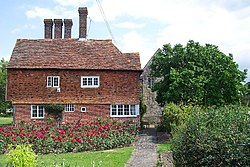Horne's Place
| Horne's Place | |
| Kent | |
|---|---|
 Hornes Place and Chapel, Kent | |
| Location | |
| Grid reference: | TQ95753086 |
| Location: | 51°2’37"N, 0°47’28"E |
| Village: | Appledore |
| History | |
| Built 1276 | |
| Country house | |
| Information | |
Horne's Place, is a late mediæval timber-framed house in Appledore in Kent. Beside it, and once joined to the house, is a private chapel of the same age.
The house is still a private house, and designated a Grade II* listed building.[1] Horne's Place Chapel is now managed separately: it is open to view and managed by English Heritage.
History
In the reign of King John (during 1166 – 1216), 'Ralph de Horne' (of Kenardington), was one of the recognitores magnæ assisæ, or justices of the great assize.[2]
Then in 1276, King Edward I granted land containing the manor to Matthew Horne (Ralph's son),[3] and the house remained in his family until the sixteenth century, taking its name from the family. In Matthew Hornes's time a chapel was built, which allowed the Horne family to attend services conveniently at home rather than obliging them to travel to the parish church: receipt of a licence for worship in 1366 was an indicator of the family's high status.
Matthew's descendant, William Horne, was one of the conservators of the peace in 1367.[2]
In 1381, the property was entered during Watts Rebellion, and £10 worth of goods stolen from the farmhouse.[1]
In 1392, Henry Horne (MP) inherited Horne's Place.[4]
In 1406, Michael Horne (son of Matthew Horne) became a Sheriff of Kent.[5] He is also thought to be buried in a tomb in the chapel.[2]
Later, Robert Horne (Michael's son) also became a Sheriff of Kent in 1452. Soon after the Horne family left Horne's Place and moved to 'Little Horne' in Kenardington. The estate of Horne's Place was known as 'Great Horne'.[2] Robert Horne, then died in 1461.[4]
The house was given by Queen Mary I to Philip Chute (a yeoman of the guard in 1536).[6]
The house remained a private house but the chapel was used as a barn in the 19th and early 20th centuries.[3]
The hall wing of the manor house was originally linked to the chapel by a doorway, which is now blocked, along its north wall.[3]
See also
Outside links
References
- ↑ 1.0 1.1 Horne's Place Chapel, Appledore - British Listed Buildings
- ↑ 2.0 2.1 2.2 2.3 Hasted, Edward: The History and Topographical Survey of the County of Kent (1798), pages 244-249
- ↑ 3.0 3.1 3.2 Horne's Place Chapel: History and research
- ↑ 4.0 4.1 "HORNE, Henry, of Horne's Place in Appledore, Kent". www.historyofparliamentonline.org. http://www.historyofparliamentonline.org/volume/1386-1421/member/horne-henry. Retrieved 5 August 2014.
- ↑ Hasted, Edward: The History and Topographical Survey of the County of Kent (1797), pages 177-213}}
- ↑ "CHUTE (CHOWTE), Philip (by 1506-67), of Horne Place, Appledore, Kent". www.historyofparliamentonline.org. http://www.historyofparliamentonline.org/volume/1509-1558/member/chute-(chowte)-philip-1506-67. Retrieved 5 August 2014.